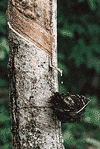 whatever the reasons, the really odd thing is that these lattices
contain a hydrocarbon polymer - natural rubber!
whatever the reasons, the really odd thing is that these lattices
contain a hydrocarbon polymer - natural rubber!
Many plants, including dandelions, produce a
milky white liquid known as latex. The reasons for producing this liquid are unclear, but it
might be as a means of helping wounds to heal quickly or as an energy
store. But  whatever the reasons, the really odd thing is that these lattices
contain a hydrocarbon polymer - natural rubber!
whatever the reasons, the really odd thing is that these lattices
contain a hydrocarbon polymer - natural rubber!
In the early days of the rubber industry, many different plants were tried and indeed used, including the so-called "rubber plant" (Ficus Elastica), which is grown as a house plant in the U.K. But the highest yield and the best quality rubber comes from a tropical tree known as Hevea Brasiliensis. Apart from a small amount of natural rubber produced from a Mexican desert bush called Guayule, all natural rubber is now produced from Hevea Brasiliensis.
The latex is obtained from the tree by "tapping". This is done by wounding the tree by cutting out a thin strip of bark, usually in the form of a part spiral. The latex exudes from the cut and is collected in a cup. This process is repeated every day or so, moving down the bark, until a whole panel of bark has been removed. Luckily it grows back whilst another panel is used.
Latex is an emulsion of small rubber particles in a "serum" (mainly water), where each particle is coated with a layer of protein which enables it to stay in suspension. It is very similar to milk, which is an emulsion of coated fat globules in whey (mainly water), although latex is slightly "thicker" than milk.
It is possible to obtain a solid crude rubber by drying off the water, and this was the method used by the Amazonian Indians. However, there is a much better method, and like milk it is possible to separate out (coagulate) the emulsified particles with acid. Having coagulated the rubber, it can be separated from the liquid and most of the non-rubber solids. It is then washed with water and dried, before being baled and shipped off to the users. Of course the process is a little more complex than that, and a great deal of care is taken to ensure that the quality is high and consistent.
Latex itself is also used directly in a number of processes. In this case it is concentrated in a centrifuge (exactly like making cream from milk!) and stabilized with ammonia before being shipped for use: the adhesive "Copydex" will give you a fair idea of the properties of concentrated latex.
Changes were also taking place in processing. The crude rubber from the Amazonian jungle came in large lumps, which were so hard that in order to use the rubber it was necessary to dissolve it in a solvent such as coal-tar naphtha. Other ingredients were then added and the solution used to make the product with the solvent being left to dry out. But this was an extremely costly way of making an article. Not only was the rubber itself very expensive, but also the solvents, and they were not recovered and reused.